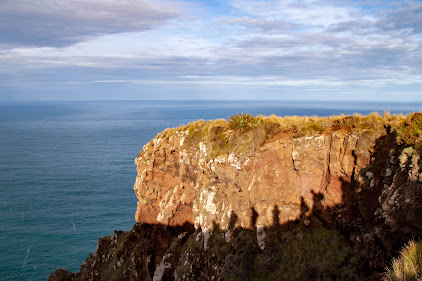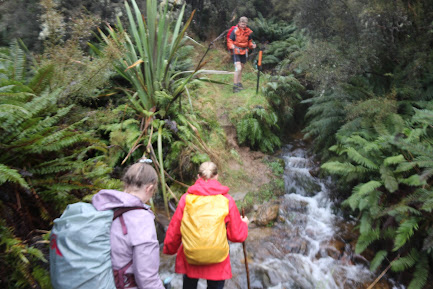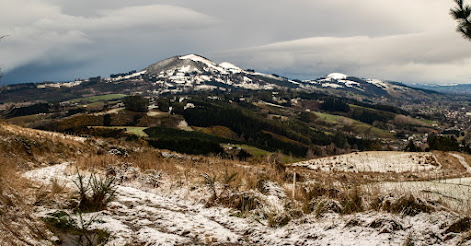Midwinter is arguably the best time to visit Sandymount - there is just something about this time of year that makes this special place even more magical. After a week of Dunedin’s notorious cold, grey weather that hugged the hills, it was an absolute delight to draw back the curtains on Saturday morning to a clear sky with not a breath of wind. 11 of us met at the clubrooms, a pleasing amount for a long weekend. As this was a through trip, the arrangements were slightly more complicated as a car shuffle was needed to avoid unnecessary road walking. Those left waiting whilst the drivers rearranged the cars had no complaints as they enjoyed a stunning vista overlooking Hoopers Inlet from the car park.

It wasn’t long before the group was reunited, and we set off to circumnavigate Sandymount before tackling the climb up to the summit. We headed off in a clockwise direction, passing through a tunnel of towering macrocarpa trees. A few minutes later we emerged into farmland, evidenced by the muddy ruts on the road caused by various farm vehicles.
Trying our best to avoid bogs, we made our way down to a relatively new lookout, recently installed by DOC (presumably to make up for the removal of the viewing platforms at the nearby Chasm and Lovers Leap). The views from here are some of the best on the Otago Peninsula, and they were made even more dreamier by the early morning light. The breathtaking scenery in front of us made stopping for morning tea an easy decision, despite being less than 10 minutes into the trip.
The panoramic views from here are simply stunning and highlights many predominant features of the Peninsula. Directly in front of us was
Mt Charles/Poatiri, the highest point on the Peninsula, whose lower flanks were shrouded in the mist whilst the rising sun lit up the summit. Stretching out in front of Mt Charles were the pale sands of Allans Beach, contrasted by the sparkling turquoise waters of the Pacific Ocean. Further to the left was Hoopers Inlet encompassed by the rolling green and gold hills of the Peninsula, with the distant hills of the northern skyline on the horizon.
This turned into one of the longer morning tea stops, as we enjoyed chit chatting as much as we were enjoying the spectacular landscape. From here, we opted to head out towards the tussock covered headland, otherwise known as The Chasm. We admired the sheer cliffs that plummeted steeply into the raging ocean from a safe distance. It was exhilarating looking out over the endless Pacific Ocean and really made you feel like you were standing on the edge of the world.
Our circumnavigation around Sandymount continued through farmland, skirting the cliffs as we headed for the summit. As we reached the junction between Sandfly Bay and Sandymount, the terrain underfoot changed from soggy paddocks to sand. This made our 100m climb to the summit just a little bit tricker, as we slid backwards with every step. We were also battling a slightly overgrown track, which only made reaching the top more rewarding.
The summit of Sandymount is marked with a trig and a plane table, useful features as they provide a means to get above the head-high flaxes and shrubs that have taken over. The views from the summit provide a different perspective from earlier. We were treated to uninterrupted views of the coastline snaking from Sandfly Bay to
Boulder Beach and further towards Dunedin. The clear skies meant we could see many places we have visited on previous trips - namely
Harbour Cone/Hereweka,
Saddle Hill/Pukemakamaka,
Taieri Mouth,
Seal Point and
Mt Cargill/Kapukataumahaka.Now it was time for the fun part - the descent down 300m of sand dunes to Sandfly Bay. The more mature among us walked down in a sensible fashion, while others delighted in the child-like fun of running and jumping down. It didn’t take long to descend and before we knew it we were walking amongst the sand hills that surrounded the beach. There is something about sand dunes that feel extra-terrestrial, almost like you could be walking on Mars.
Sandfly Bay is a popular resting ground for the New Zealand sea lion and great care is often required to avoid becoming their next meal. On high alert as we wound our way down the narrow path that led onto the beach, we found ourselves pushing through waist-high Marram grass in order to give the three slumbering sea lions on the track some space.
Once on the beach, we found a perch about 20m away from a group of half a dozen sunbathing sea lions dozing on the water's edge. They provided plenty of entertainment as we fuelled up for the slog up to the carpark. Every so often, they would seemingly get a burst of energy and decide to assert their dominance. One sea lion would approach another barking and growling and before long they were all going at it, baring their teeth and nipping at each other. Just as quickly as the commotion started, it would stop again as they flopped down to regain their energy, before repeating the cycle again.
Being about one kilometre long, it didn’t take us long to make our way to the southern end of the beach. We made sure to keep our distance from the sea lions, some of which were among the biggest I have ever seen! Jumping over a small creek, we started making our way up the sandhills to the carpark.
With past visions of steep sand hills rising directly from the beach floating in our minds, it was a pleasant surprise to see DOC have done some work in rerouting the track so it sidles around. This was much easier than the scramble it used to be, and it didn’t take us long at all to climb over 100m to the car park.
By Jade Pettinger









.jpg)















































